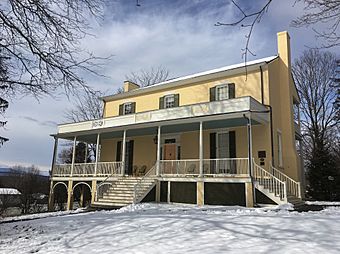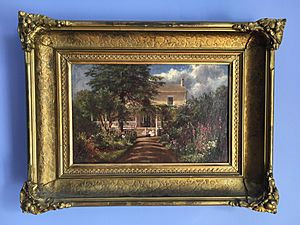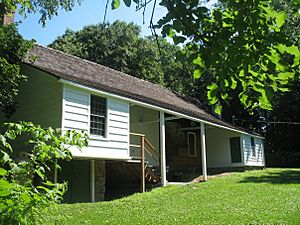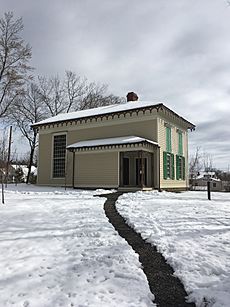Thomas Cole House facts for kids
|
Thomas Cole House
|
|

Thomas Cole House in 2018
|
|
| Location | 218 Spring Street, Catskill, New York |
|---|---|
| Area | 3.5 acres (1.4 ha) |
| Built | 1812 |
| Website | Thomas Cole National Historic Site |
| NRHP reference No. | 66000522 |
Quick facts for kids Significant dates |
|
| Added to NRHP | October 15, 1966 |
| Designated NHL | June 23, 1965 |
| Designated NHS | December 9, 1999 |
The Thomas Cole House, also known as Cedar Grove, is a special place in American art history. It was the home and studio of Thomas Cole. He was a famous painter and the person who started the Hudson River School of American painting.
The house is located in Catskill, NY, United States. Thomas Cole lived and worked here from 1833 until he passed away in 1848. This property was recognized as a National Historic Landmark in 1965. Later, in 1999, it became a National Historic Site.
Contents
History of the Thomas Cole House
Early Years of Cedar Grove
Long ago, in 1684, a man named Gysbert uyt den Bogaert bought a large piece of land. It was about 460 acres near the Hudson River. Over time, this land was divided and sold to different people.
In the late 1700s, a doctor named Thomas Thomson bought some of this land. He built a house there, finishing it in 1816. This house was called 'Cedar Grove'. It was a working farm with animals and crops. The Thomson family, including many relatives, lived there.
Thomas Cole Makes Cedar Grove His Home
When Thomas Cole arrived in the early 1830s, Cedar Grove was a well-kept farm. Cole was looking for a permanent home in the Catskill area. He rented space from the Thomson family to live and paint.
In November 1836, Cole married Maria Bartow. She was the niece of John A. Thomson, who was the head of the Thomson family. Cole and Maria lived in the main house and raised their children there.
Cole loved the Catskill landscape around Cedar Grove. He painted many famous scenes of the area. These include paintings like Lake with Dead Trees and Kaaterskill Falls. The house still offers beautiful views of the Catskill mountains today. Cole wrote about his love for the place in poems and letters.
In 1839, Cole moved into a new studio. It was part of a barn built by John A. Thomson. This studio still stands today. It has an extra window that was added to give Cole more light for his paintings. He created important works here, like The Voyage of Life.
After John A. Thomson died in 1846, Cole built another studio. Sadly, this second studio was taken down in the 1970s. In February 1848, Thomas Cole became sick and passed away in his bedroom at Cedar Grove. He left behind his wife and four children.
After Cole's Time
After Thomas Cole died, many artists visited Cedar Grove. Some even rented his studio to paint. Artists like Frederic Edwin Church, Jasper Francis Cropsey, and Charles Herbert Moore came to see the house and grounds. They made paintings and sketches of the property. People were very interested in Cole's workplace because he was such an important artist.

Over the years, the Cole family faced some financial difficulties. The size of the property became smaller. Some land was sold, and some was used for public projects like roads. In 1933, the building of the nearby Rip Van Winkle Bridge almost caused the house to be torn down. But the Cole family worked hard to save it. Only a small part of the land was taken for the bridge.
In the 1960s, the historic flower beds were no longer cared for. An old cottage that Cole had rented was also demolished. New York State decided not to preserve the property at first. But in 1981, a group called the Catskill Center for Conservation and Development bought it. They sold it in 1982 to four art lovers who started to restore it.
The National Park Service did not buy the site. However, with help from a grant, the Greene County Historical Society bought it in 1998. Restoration work began seriously, and Cedar Grove opened to the public in 2001.
In 2016, Cole's "New Studio" was rebuilt. This studio was originally built in 1846 and taken down in 1973. The reconstruction used old photos, sketches by Frederic Church and Jasper Cropsey, and a painting by Charles Herbert Moore.
In 2019, the Thomas Cole National Historic Site worked with Olana State Historic Site. They opened the Hudson River Skywalk. This is a walking path across the Rip Van Winkle Bridge. It helps connect these two important historic sites for visitors.
|





